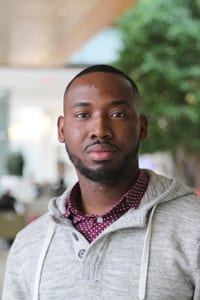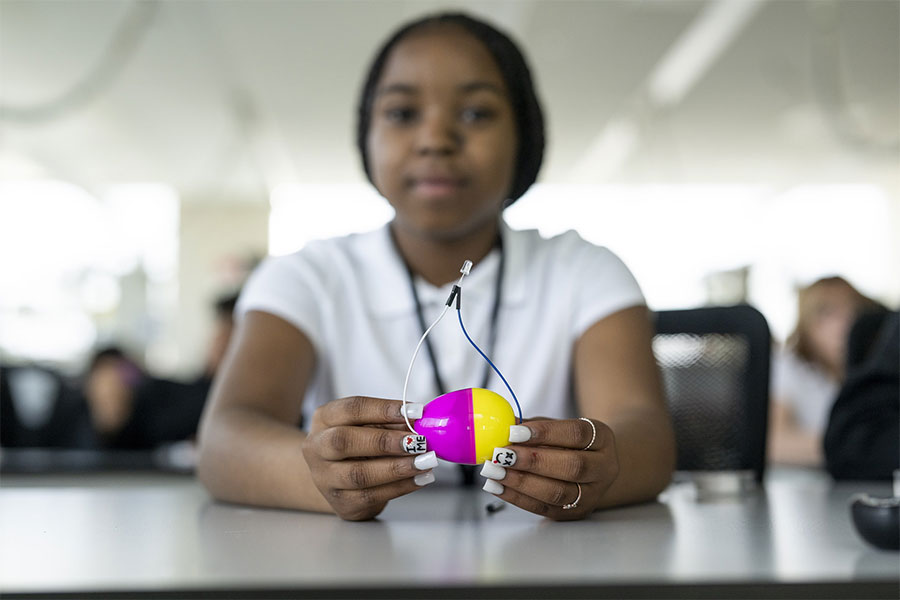The school year kicks off in a few weeks, but for some students “school” hasn’t really been on summer break.
In one activity, students are building triboelectric nanogenerators. The students combine common household items, including a plastic Easter egg, a bouncy ball, a few copper wires, an LED light, and aluminum foil. Their tiny handmade electronics are powered by triboelectricity, more commonly known as static electricity.
This is Afterschool Expeditions, an outreach program at the Morgridge Institute that brings science exploration to community nonprofit centers in Madison.
The power of Afterschool Expeditions is the unique way it works: UW–Madison scientists and researchers are paired with college students in the Badger Volunteer program. Together, they travel once a week to community centers across the city during the spring, fall, and summer.

“We go to underserved communities to promote the Wisconsin Idea,” says Jerrod Buckner, who runs Afterschool Expeditions. “We’re a research institute that connects UW–Madison researchers, college students, and youth. It’s collaborative, not informative.”
The Wisconsin Idea — a long-held principle that the university should serve all people in the state — is embedded in the Morgridge Institute’s mission to inspire a curiosity and love of science.
For Buckner, that really means going outside the institute and the university. During his six years at Morgridge, he’s transformed Afterschool Expeditions from a previously on-site program, to one that travels weekly to meet a specific community’s needs.
“There’s a large community center resource here in Madison,” Buckner says. “They serve many origins of people and cultures, and they all do very different things. Creating partnerships with these communities is a powerful way to share the Wisconsin Idea.”
The summer schedule has crisscrossed the isthmus, partnering with Vera Court Neighborhood Center, Neighborhood House, the Elver Park Neighborhood Center operated by the Wisconsin Youth Company at Elver Park, MSCR-Midvale, BLW Center, and Goodman Community Center, just to name a few.
Leveraging the summer weather, some community centers like Vera Court have also traveled to campus to explore Babcock Dairy and the Allen Centennial Gardens.
“The Vera Court kids and staff have been excited to take a look at the UW–Madison campus and the wonders it has to offer. Our group has a thirst for knowledge and dynamic activity, so we try our best to find partners and programs that are up to the task of indulging those wants and needs in a fun and educational way,” says Tom Qualls, program director at Vera Court. “Jerrod, his team, and the Morgridge Center have been such a wonderful resource for our community center and summer programming. Having the opportunity to expose our kids to spaces they may have never seen before is an invaluable experience and truly makes a difference in our families’ lives.”
Outside of summer field trips, Afterschool Expeditions is taught at a community center. A scientist brings an hour of programming for up to 20 elementary students and sometimes middle schoolers.
It’s about having fun through exploration and autonomy, says Shelly Grandell, assistant director of education and outreach at the Materials Science Research Center (MRSEC) at UW–Madison.
Grandell, who is a science teacher by training, has taken many activities on the road that invite students to learn about the materials that exist all around us — whether they are part of our everyday lives (like LEDs) or part of the natural world (like lotus leaves).

In one activity, students inspect lotus leaves which are naturally hydrophobic. Grandell asks them to consider the properties of the leaves and how that material relates to everyday materials. For example, what might we learn to develop more effective waterproof clothing? Umbrellas? Or even water-resistant glass?
“One of the most wonderful parts about this program is that we are going into the students’ safe space,” Grandell says. “That’s where they may be more comfortable to ask questions, interact and be a little more bold. I think that really opens up an opportunity for them to explore a little more freely.”
Admittedly, the hour goes by quickly. But Grandell knows that the impact is more than just that. Students may share their experience and excitement with others and she’s built that into the activities, creating take-home kits when possible.
“Taking science and STEM excitement and passing it on is really one of the great things,” says Grandell. “Knowing that students are going to go home and do the activities in their own space and share it with other people — that means we’re doing the good work.”
Through private support, the Morgridge Institute provides funding to scientists like Grandell to purchase supplies and materials for Afterschool activities. The institute also provides a travel stipend to student volunteers who often do not have reliable transportation to travel to community centers.
For Grandell, the Badger Volunteers provide a wonderful opportunity for students to interact, learn, and imagine their own journey into higher education, STEM, and the world of discovery.
